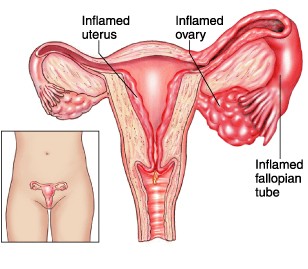Pelvic Inflammatory Disease (PID) is an infection of the female reproductive organs. It most often occurs when sexually transmitted bacteria spread from your vagina to your uterus, fallopian tubes or ovaries. PID affects nearly 1,000,000 women each year.
Pelvic Inflammatory Disease (PID) Symptoms
Women with PID may have only mild pain or no symptoms at all, even though serious damage to their internal reproductive organs may be occurring. Some women with PID may experience the following symptoms:
- Lower abdominal pain ranging from mild to severe
- Fever, sometimes chills
- Abnormal or heavy vaginal discharge that may have an unpleasant odor
- Painful intercourse
- Painful, frequent or difficult urination
Can Pelvic Inflammatory Disease (PID) lead to other problems?
PID can cause permanent damage by developing scar tissue on the female internal reproductive organs. The scar tissue can completely block the fallopian tubes, which prevents the sperm and egg from meeting and causes infertility.
Approximately 100,000 women a year begin struggling with infertility as a result of PID. The scar tissue may partially block or slightly damage the fallopian tube.
This can prevent the fertilized egg from leaving the tube creating an ectopic or tubal pregnancy. Ectopic pregnancies can rupture the fallopian tubes causing severe pain, internal bleeding, and even death. Scarring of the fallopian tubes and ovaries can also lead to pelvic pain that lasts for months or even years.
What causes Pelvic Inflammatory Disease?
PID is caused by vaginal intercourse with a partner infected with Gonorrhea or Chlamydia. The more sexual partners a woman has, the greater the risk of PID. PID is a common progression from an infection of either chlamydia, gonorrhea, or in rare cases, bacterial vaginosis.
How is the disease diagnosed?
PID is difficult to diagnose because symptoms are often mild and many cases go undetected. There are no specific tests for PID. If you are sexually active and experiencing lower abdominal pain, the first thing your healthcare provider will probably do is to run cultures of your cervix to test for chlamydia and gonorrhea. An ultrasound or possibly surgery may be necessary to diagnose PID.
How is Pelvic Inflammatory Disease Treated?
The bacteria that cause PID may be treated and cured with antibiotics administered orally or intravenously. The damage caused by scarring from PID may not be reversed. Approximately 25% of women with PID must be admitted to the hospital for treatment.
Can It be prevented?
There are only two ways to prevent PID. The first is to refrain from sexual contact of any kind, allowing you to avoid contracting chlamydia and gonorrhea.
The second is to be in a long-term monogamous relationship such as marriage. The use of condoms does reduce the risk of transmission of chlamydia and gonorrhea, but it does not prevent it. According to a study presented at the 2002 National STD Prevention Conference, there is a 50% risk reduction by using condoms.
Want to Know More?
- Most Common Pregnancy Complications
- Understanding a High-risk Pregnancy
- Sharp Pain During Pregnancy: Causes & Symptoms
Compiled using information from the following sources:
Infectious Diseases of the Female Genital Tract Fourth Ed. Sweet, Richard L, et al, Ch. 14.
Centers for Disease Control and Prevention, https://www.cdc.gov






